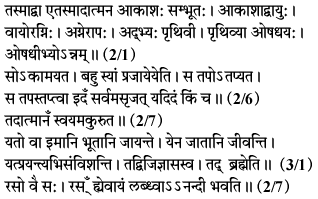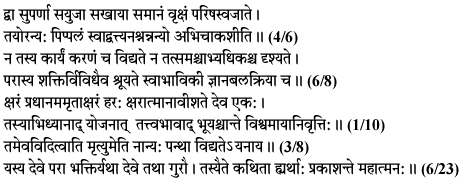(63) The Upnishads.
There were 1,180 Upnishads,
related to 1,180 branches of the Vedas. Out of them about 200 Upnishads
are still available. All the Upnishads are equally important and valuable,
but the Muktikopnishad has referred to the 108 Upnishads that contain the
philosophies of God realization and the basic facts of the Divine world.
We will explain in brief the philosophies of 5 prominent Upnishads to
give you a general idea of their contents.
1. Ishopnishad.
This is the first one in the list of the Upnishads and
is the 40th chapter of Shukl Yajurved (sanhita) so it has its own
importance. It starts with the very first word Ishwar which means
the Divine personality of God.

It has only 18 verses. In its first verse it gives a
condensed philosophy of God and God realization which is the gist of the
Upnishadic philosophy. It says,
“The entire universe (visual and non-visual) is filled,
impregnated and enveloped with the omnipresence of the Divine personality
of God. All kinds of wealth of the visual world with all of its
fascinating luxuries is just an illusion that does not belong to anyone.
 So, don’t be attached to it. So, don’t be attached to it. Holding the personal form of God in
your mind all the time, Holding the personal form of God in
your mind all the time,
 and living a renounced life, and living a renounced life, pass on the days of your life whatever good or bad comes according to your
destiny
pass on the days of your life whatever good or bad comes according to your
destiny
This statement establishes the philosophy of karm
yog which is detailed in the Gita. Ishopnishad in this verse
specifically emphasizes on remembering the personal form of God
and indicates to rely on His Grace.
2. Taittariya Upnishad.
It has three big chapters called Shikcha Valli,
Brahmanand Valli and Bhrigu Valli with their subsections. It tells more
about the creation of the universe. It says,

“From Him, first, the space came into being. Then, air,
fire, water and earth, and then the vegetation came into being.” (2/1) “He
thought of creating the universe, and the universe was created.” (2/6) “He
Himself became the universe.” (2/7)
“From Whom the universe and all the souls emerge; due
to Whom all the souls sustain their life; and in Whom they enter after the
total dissolution of the universe; that One is knowable and attainable,
and That is brahm.” (3/1) Taittariya Upnishad further says that
that brahm is eternally personified which is His prime form and He
Himself (sah) is the absolute Bliss and Divine love (rasah).
A soul becomes Blissful only when he receives that Bliss. (2/7)
3. Shvetashvatar Upnishad.
It has six chapters and is one of the important
Upnishads. It explains the definite characteristics of all the three:
soul, maya and God; and also tells the definite procedure of God
realization. It says,

God and the soul, both reside together in the heart of
every being. Figuratively describing the human body as a tree, the
Shvetashvatar Upnishad says, “Two birds, which are eternal friends, live
on the same tree, whereas one bird (the soul) is enjoying eating the fruit
(sensual pleasures) of that tree and the other one (God) is simply
watching the first one.” (4/6) “That God is all-absolute by all means. He
doesn’t have separate body, mind and soul configuration like human beings.
You can say that His whole body is His soul and mind, or His body, mind
and soul are all one. Nothing is equal to Him and nothing is more than
Him; He is the ultimate supreme. He has many Divine powers, just like:
knowledge (called chit tattva), almightiness, action (for example,
the creation, maintenance and dissolution of the universe) and His most
important personal power (swabhaviki) called yogmaya or
ahladini shakti.” (6/8)
“Mayic creations which are deteriorative, and
the souls enjoying (harah) the objects of maya, are both
eternal. The one Who is above both and Who is the controller of both is
supreme God. When a devotee lovingly engrosses his mind in Him and
constantly remembers Him, only then his mayic bondage is broken.”
(1/10) “Only after realizing Him a soul may cross the ocean of maya;
there is no other way.” (3/8)
The last verse reveals the true secret of God
realization. It says, “When a devotee has infallible love and devotion (bhaktih)
for his beloved and Gracious God (Devah), and he is equally
dedicated to his Spiritual Master (who is a God realized Saint), only then
that soul (with the Grace of the Saint) perceives, conceives and
understands the Divine secrets (and becomes God realized).” (6/23)
4. Tripadvibhushit Mahanarayanopnishad.
This is one of the important Upnishads revealing
certain eminent issues that were mentioned in the first eleven of the 108
Upnishads, but not explained.
In the first chapter it tells that God has two forms:
personal, Who has all the virtues, and impersonal, which never ever shows
any virtues; and that both forms are omnipresent in the world
 . If someone questions: Which one is
the main form? In the second chapter it tells that, . If someone questions: Which one is
the main form? In the second chapter it tells that,
 without the personal form, the
impersonal form cannot exist. So, personal form of God is the main form.
This theme was already mentioned in Mundakopnishad, without the personal form, the
impersonal form cannot exist. So, personal form of God is the main form.
This theme was already mentioned in Mundakopnishad, and Shvetashvatar Upnishad, and Shvetashvatar Upnishad, which means that only by
worshipping Him and by knowing Him the
mayic bondage could be eliminated because nirakar brahm is
established in the sakar brahm. This is also declared in the
Gita. In the eighth chapter which is the last one, it says, which means that only by
worshipping Him and by knowing Him the
mayic bondage could be eliminated because nirakar brahm is
established in the sakar brahm. This is also declared in the
Gita. In the eighth chapter which is the last one, it says,

“Without bhakti, brahm gyan can never be
attained. Thus a soul, leaving all other practices of heart
purification, should firmly stick to the path of bhakti and
establish his mind only in bhakti, only in bhakti, and
only in bhakti, because through bhakti one can attain anything
and everything in the Divine world.”

It means, “The eternal Vaikunth, the abode of Maha
Vishnu, is the eternal form of unlimited Bliss that magnificently
magnifies the Blissfulness of every part of Vaikunth where all the Devotee
Saints of Bhagwan Vishnu go and live forever.” The procedure, as to how a
liberated soul enters the Divine abode, is described as thus in its fifth
chapter:

“After God realization, when the bhakt Saint is
going to enter the Divine abode, his physical body is replaced with the
Divine body which is substantially the Divine Bliss itself, exactly the
same as of Maha Vishnu. With that Divine body he enters Vaikunth abode.”
This theme was briefly mentioned in the Kathopnishad,
 , which means that the God realized
Saint after crossing the field of maya enters (apnoti) the
Divine abode of God. The term ‘abode of God Vishnu’ is a generalized term
that means the Divine abode of any personal form of God, either Vishnu or
Ram or Krishn. , which means that the God realized
Saint after crossing the field of maya enters (apnoti) the
Divine abode of God. The term ‘abode of God Vishnu’ is a generalized term
that means the Divine abode of any personal form of God, either Vishnu or
Ram or Krishn.
5. Gopal Poorv Tapiniyopnishad.
The statement of Taittariyopnishad, “He is the absolute
Bliss or He is the Bliss of Bliss,”
 is further explained in Gopal Poorv
Tapiniyopnishad. The word ‘rasah’ means the Bliss of the
Divine Bliss, or the Divine love. This Upnishad has two chapters. In
the first chapter it says, is further explained in Gopal Poorv
Tapiniyopnishad. The word ‘rasah’ means the Bliss of the
Divine Bliss, or the Divine love. This Upnishad has two chapters. In
the first chapter it says,

“(1) Krishn word means the absolute and eternal Bliss;
He is supreme brahm. (2) He is the supreme God (parmam daivtam).
(3) Govind Krishn Himself is the eternal life, knowledge and Bliss.”
In the second chapter it reveals the topmost secret of
the Divine world and says,

“Thus, only Krishn is the supreme
form of God. So, remember Him (dyayet), adore Him (bhajet)
and (then with His Grace) experience His Divine love (raset).”
The word rasah has come only for Krishn. It has never come for
Vishnu or Shiv etc. in the Upnishads. This situation clearly indicates
that Krishn is the ‘Bliss of the Bliss,’ whereas Vishnu, including all
other almighty forms of God, are just the form of unlimited Bliss. Thus it
is evident that the almighty forms of God (like Vishnu etc.) are
established in the personality of Krishn in a self-submissive style. Just
like the ‘Bliss of the Bliss’ is the source of the Bliss, or you can say
that the Bliss is established in its source, ‘Bliss of the Bliss.’

|